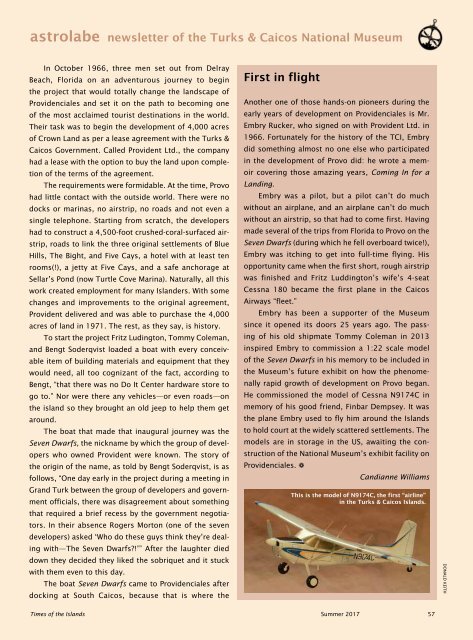Times of the Islands Summer 2017
Presents the "soul of the Turks & Caicos Islands" with in-depth features about local people, culture, history, environment, businesses, resorts, restaurants and activities.
Presents the "soul of the Turks & Caicos Islands" with in-depth features about local people, culture, history, environment, businesses, resorts, restaurants and activities.
You also want an ePaper? Increase the reach of your titles
YUMPU automatically turns print PDFs into web optimized ePapers that Google loves.
astrolabe newsletter <strong>of</strong> <strong>the</strong> Turks & Caicos National Museum<br />
In October 1966, three men set out from Delray<br />
Beach, Florida on an adventurous journey to begin<br />
<strong>the</strong> project that would totally change <strong>the</strong> landscape <strong>of</strong><br />
Providenciales and set it on <strong>the</strong> path to becoming one<br />
<strong>of</strong> <strong>the</strong> most acclaimed tourist destinations in <strong>the</strong> world.<br />
Their task was to begin <strong>the</strong> development <strong>of</strong> 4,000 acres<br />
<strong>of</strong> Crown Land as per a lease agreement with <strong>the</strong> Turks &<br />
Caicos Government. Called Provident Ltd., <strong>the</strong> company<br />
had a lease with <strong>the</strong> option to buy <strong>the</strong> land upon completion<br />
<strong>of</strong> <strong>the</strong> terms <strong>of</strong> <strong>the</strong> agreement.<br />
The requirements were formidable. At <strong>the</strong> time, Provo<br />
had little contact with <strong>the</strong> outside world. There were no<br />
docks or marinas, no airstrip, no roads and not even a<br />
single telephone. Starting from scratch, <strong>the</strong> developers<br />
had to construct a 4,500-foot crushed-coral-surfaced airstrip,<br />
roads to link <strong>the</strong> three original settlements <strong>of</strong> Blue<br />
Hills, The Bight, and Five Cays, a hotel with at least ten<br />
rooms(!), a jetty at Five Cays, and a safe anchorage at<br />
Sellar’s Pond (now Turtle Cove Marina). Naturally, all this<br />
work created employment for many Islanders. With some<br />
changes and improvements to <strong>the</strong> original agreement,<br />
Provident delivered and was able to purchase <strong>the</strong> 4,000<br />
acres <strong>of</strong> land in 1971. The rest, as <strong>the</strong>y say, is history.<br />
To start <strong>the</strong> project Fritz Ludington, Tommy Coleman,<br />
and Bengt Soderqvist loaded a boat with every conceivable<br />
item <strong>of</strong> building materials and equipment that <strong>the</strong>y<br />
would need, all too cognizant <strong>of</strong> <strong>the</strong> fact, according to<br />
Bengt, “that <strong>the</strong>re was no Do It Center hardware store to<br />
go to.” Nor were <strong>the</strong>re any vehicles—or even roads—on<br />
<strong>the</strong> island so <strong>the</strong>y brought an old jeep to help <strong>the</strong>m get<br />
around.<br />
The boat that made that inaugural journey was <strong>the</strong><br />
Seven Dwarfs, <strong>the</strong> nickname by which <strong>the</strong> group <strong>of</strong> developers<br />
who owned Provident were known. The story <strong>of</strong><br />
<strong>the</strong> origin <strong>of</strong> <strong>the</strong> name, as told by Bengt Soderqvist, is as<br />
follows, “One day early in <strong>the</strong> project during a meeting in<br />
Grand Turk between <strong>the</strong> group <strong>of</strong> developers and government<br />
<strong>of</strong>ficials, <strong>the</strong>re was disagreement about something<br />
that required a brief recess by <strong>the</strong> government negotiators.<br />
In <strong>the</strong>ir absence Rogers Morton (one <strong>of</strong> <strong>the</strong> seven<br />
developers) asked ‘Who do <strong>the</strong>se guys think <strong>the</strong>y’re dealing<br />
with—The Seven Dwarfs?!’” After <strong>the</strong> laughter died<br />
down <strong>the</strong>y decided <strong>the</strong>y liked <strong>the</strong> sobriquet and it stuck<br />
with <strong>the</strong>m even to this day.<br />
The boat Seven Dwarfs came to Providenciales after<br />
docking at South Caicos, because that is where <strong>the</strong><br />
First in flight<br />
Ano<strong>the</strong>r one <strong>of</strong> those hands-on pioneers during <strong>the</strong><br />
early years <strong>of</strong> development on Providenciales is Mr.<br />
Embry Rucker, who signed on with Provident Ltd. in<br />
1966. Fortunately for <strong>the</strong> history <strong>of</strong> <strong>the</strong> TCI, Embry<br />
did something almost no one else who participated<br />
in <strong>the</strong> development <strong>of</strong> Provo did: he wrote a memoir<br />
covering those amazing years, Coming In for a<br />
Landing.<br />
Embry was a pilot, but a pilot can’t do much<br />
without an airplane, and an airplane can’t do much<br />
without an airstrip, so that had to come first. Having<br />
made several <strong>of</strong> <strong>the</strong> trips from Florida to Provo on <strong>the</strong><br />
Seven Dwarfs (during which he fell overboard twice!),<br />
Embry was itching to get into full-time flying. His<br />
opportunity came when <strong>the</strong> first short, rough airstrip<br />
was finished and Fritz Luddington’s wife’s 4-seat<br />
Cessna 180 became <strong>the</strong> first plane in <strong>the</strong> Caicos<br />
Airways “fleet.”<br />
Embry has been a supporter <strong>of</strong> <strong>the</strong> Museum<br />
since it opened its doors 25 years ago. The passing<br />
<strong>of</strong> his old shipmate Tommy Coleman in 2013<br />
inspired Embry to commission a 1:22 scale model<br />
<strong>of</strong> <strong>the</strong> Seven Dwarfs in his memory to be included in<br />
<strong>the</strong> Museum’s future exhibit on how <strong>the</strong> phenomenally<br />
rapid growth <strong>of</strong> development on Provo began.<br />
He commissioned <strong>the</strong> model <strong>of</strong> Cessna N9174C in<br />
memory <strong>of</strong> his good friend, Finbar Dempsey. It was<br />
<strong>the</strong> plane Embry used to fly him around <strong>the</strong> <strong>Islands</strong><br />
to hold court at <strong>the</strong> widely scattered settlements. The<br />
models are in storage in <strong>the</strong> US, awaiting <strong>the</strong> construction<br />
<strong>of</strong> <strong>the</strong> National Museum’s exhibit facility on<br />
Providenciales. a<br />
Candianne Williams<br />
This is <strong>the</strong> model <strong>of</strong> N9174C, <strong>the</strong> first “airline”<br />
in <strong>the</strong> Turks & Caicos <strong>Islands</strong>.<br />
DONALD KEITH<br />
<strong>Times</strong> <strong>of</strong> <strong>the</strong> <strong>Islands</strong> <strong>Summer</strong> <strong>2017</strong> 57

















